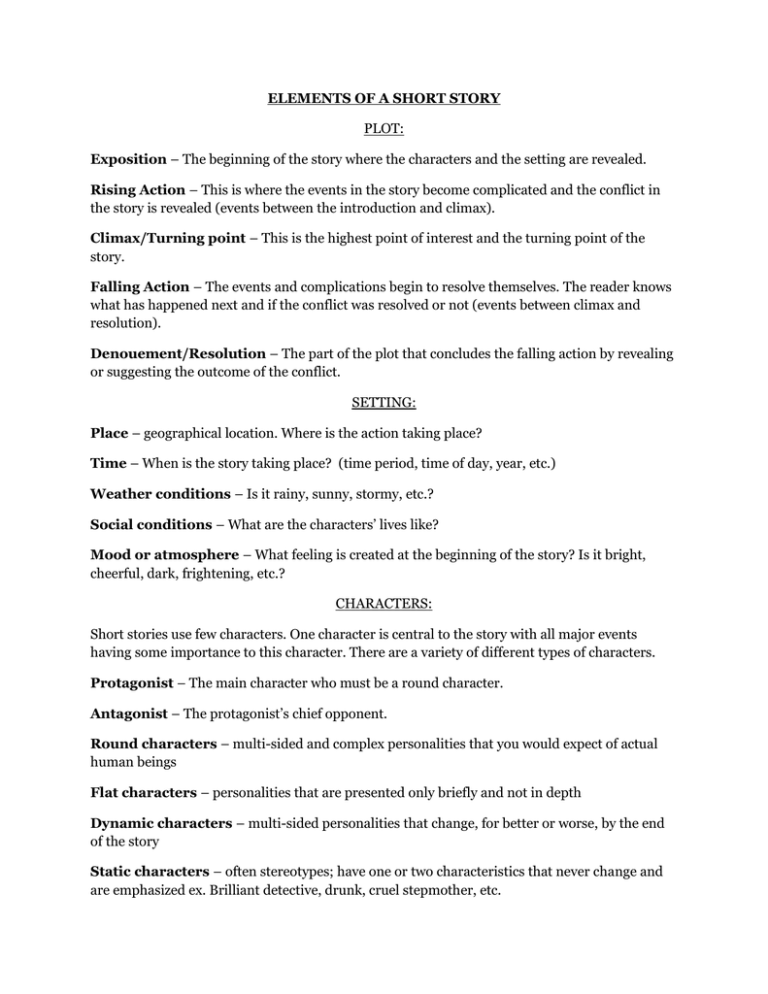ELEMENTS OF A SHORT STORY PLOT: Exposition – The
advertisement

ELEMENTS OF A SHORT STORY PLOT: Exposition – The beginning of the story where the characters and the setting are revealed. Rising Action – This is where the events in the story become complicated and the conflict in the story is revealed (events between the introduction and climax). Climax/Turning point – This is the highest point of interest and the turning point of the story. Falling Action – The events and complications begin to resolve themselves. The reader knows what has happened next and if the conflict was resolved or not (events between climax and resolution). Denouement/Resolution – The part of the plot that concludes the falling action by revealing or suggesting the outcome of the conflict. SETTING: Place – geographical location. Where is the action taking place? Time – When is the story taking place? (time period, time of day, year, etc.) Weather conditions – Is it rainy, sunny, stormy, etc.? Social conditions – What are the characters’ lives like? Mood or atmosphere – What feeling is created at the beginning of the story? Is it bright, cheerful, dark, frightening, etc.? CHARACTERS: Short stories use few characters. One character is central to the story with all major events having some importance to this character. There are a variety of different types of characters. Protagonist – The main character who must be a round character. Antagonist – The protagonist’s chief opponent. Round characters – multi-sided and complex personalities that you would expect of actual human beings Flat characters – personalities that are presented only briefly and not in depth Dynamic characters – multi-sided personalities that change, for better or worse, by the end of the story Static characters – often stereotypes; have one or two characteristics that never change and are emphasized ex. Brilliant detective, drunk, cruel stepmother, etc. Characterization is the information given to the reader about who the characters are. The author may reveal a character in several ways. • Through direct statements by the narrator/author (direct characterization) • His or her physical appearance • What he or she says, thinks, feels, and dreams • What he or she does or does not do • What others say about him or her and how others react to him or her Characters are convincing if they are consistent, motivated, and life-like. CONFLICT Conflict is not limited to arguments. Conflict is any form of opposition that a character faces. External – An outward problem. Internal – A problem that a character has within him/herself. Man vs. Man (physical) – The leading character struggles with his physical strength against other men, forces of nature, or animals. Man vs. Nature – The leading character struggles with the forces of nature. Man vs. Society (social) – The leading character struggles against ideas, practices, or customs of other people. Man vs. Self (psychological) – The leading character struggles with him/herself, with his or her own soul, ideas of right or wrong, physical limitations, choices, etc. POINT OF VIEW First person – The story is told by the protagonist or another character that interacts closely with the protagonist or other characters. Use I, me, we, my, etc.. Innocent Eye – The story is told through the eyes of a child; therefore, his or her judgment is different from that of an adult. Second person – The narrator tells the story to another character or to the reader using “you.” Second person POV is the least commonly used. Third person Omniscient – literally means “all knowing.” The narrator has free access to the thoughts, feelings, and motivations of any character. Third person Limited – The story is told by a narrator from a viewpoint of one of the characters, usually the main character. The reader has access to the thoughts and feelings of only one character. SYMBOLISM: the practice or art of using an object or a word to represent an abstract idea. An action, person, place, word, or object can all have a symbolic meaning. When an author wants to suggest a certain mood or emotion, he can also use symbolism to hint at it, rather than just blatantly saying it. In literature, symbolism can take many forms including: A figure of speech where an object, person, or situation has another meaning other than its literal meaning. The actions of a character, word, action, or event that have a deeper meaning in the context of the whole story. Objects are often used to symbolize something else: A chain can symbolize the coming together of two things. Symbolism is found in colors: Black is used to represent death or evil. White stands for life and purity. THEME: Theme is the overall idea or the central topic of the story. It is the author’s underlying subject or main idea that he or she is trying to convey. (Topic + insight) The theme may be the author’s thoughts about a topic or view of human nature. The title of the short story usually points to what the writer is saying and he may use various figures of speech to emphasize his theme such as symbolism, allusion, similes, metaphors, hyperboles, or irony.









